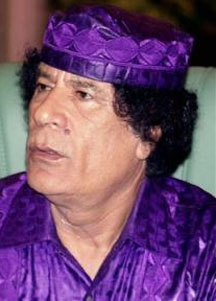KHOMS, Libya, (Reuters) – Libya’s Muammar Gaddafi deployed special squads which held suspected opponents in shipping containers, tortured them for information about insurgent networks and disposed of their bodies in unmarked graves in a campaign to smash the revolt against his rule.

Evidence gathered by Reuters in the provincial town of Khoms shows an organised system of repression with methods including delivering electric shocks to suspects’ genitals, keeping them for weeks in baking heat with only a few sips of water a day, and whipping them with an electrical cable while their hands were bound with plastic ties.
It was all part of a deliberate strategy, said Nabil Al-Menshaz, an official in the rebel council which took over Khoms after Gaddafi’s rule there collapsed last month. “They wanted to frighten the people, so if anyone was thinking of going over to the rebels, they would change their minds,” he said.
The brutality of Gaddafi’s forces in the capital, Tripoli, in the final, chaotic days before rebels overran the city has been well documented. Dozens of bodies were left lying in the streets, and witnesses described prisoners being massacred before their gaolers fled. Thousands more were killed in battles in cities like Misrata and Zawiyah.
But accounts from Khoms paint a different, and in some ways even more sinister picture. Months before the rebel victory, and out of sight of the outside world, Gaddafi was operating a system of torture – separate from the army and police – that was so well-organised the units has their own command structures and bureaucracy.
On a wall at a construction site just outside Khoms that one of the units used for detaining suspects, pro-Gaddafi forces had scrawled in red crayon the name of their unit: “Soqur Al-Fatah” – or “Hawks of Al-Fatah,” a reference to the 1969 Al-Fatah Revolution that brought Gaddafi to power. Underneath that, in the same handwriting, someone had written the words: “Death Group.”
PATTERN OF REPRESSION
Apart from the ancient Roman ruins on its Mediterranean shore, Khoms, 120 km (75 miles) east of Tripoli, is a typical provincial town. The campaign of repression carried out there is likely to have been repeated in other Libyan towns that, until Gaddafi’s rule collapsed late last month, were under the control of his forces.
“It would be consistent with what we are hearing about the repression that was going on, and the general effort to terrorise people,” said Peter Bouckaert, Emergencies Director for New York-based Human Rights Watch.
The repression began in early summer, soon after secret insurgent cells in Khoms began harassing pro-Gaddafi security forces.
“We made small explosive devices which we threw at the cars of Gaddafi forces,” said Al-Menshaz. “We made little wire spikes to burst car tyres. We attacked the houses of people who were with Gaddafi with small, home-made bombs.”
The backlash followed quickly.
Mohammed Ahmed Ali, a 54-year-old teacher of Arabic, said he was arrested on May 20 for taking part in an anti-Gaddafi protest. He was brought to a construction site near Khoms. Vacated by the multinational firm that had been building housing units there, it had been taken over by the “Hawks of Al-Fatah” unit.
A sign left over from the construction work greets people arriving at the site with the words: “Safety First.”
Here, Ahmed Ali was put inside a 40-foot long shipping container.
Nine other detainees were in his container, and there were more in another next to it; he thought about 10 people. Every few days, his guards took him out and brought him to a one-storey dormitory block that previously housed the construction workers.
Now back at the site to recount his experience, he showed the room where pro-Gaddafi soldiers interrogated him, trying to force him to confess to organizing the protest in which he had taken part. He lifted up his shirt to reveal deep welts criss-crossing his back, where he said he was hit with clubs and electrical flex.
In another room, with a metal scaffolding pole in it, he showed how, his hands tied around his knees, he was suspended from the pole and beaten again.




